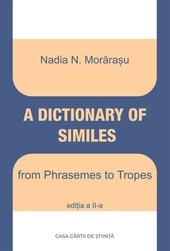A Dictionary of Similes from Phrasemes to Tropes von Nadia-Nicoleta Morarasu
Preis pro Stück:
Lei 57 / € 19,00
Inkl. Mwst.: 5% (Lei) / 7% (EUR)
zzgl. Versandkosten
Kategorie: Bücher
Seiten / Format: 270 S.; Broschiert , 13 x 20 cm
Erscheinungsjahr: 2020
Verlag: Casa Cartii de Stiinta
Sprache: Englisch
ISBN: 9786061717033
The second edition of this book proposes a deeper insight into the topic of similes, treated as multi-faceted comparison patterns. With the first edition, we chose the form of a dictionary to glide from phrases to tropes in studying similes more smoothly, considering that the material we compiled benefited greatly from the structural backbone provided by the lexicographic approach. Based on the feedback received from both specialists and students, we preserved and enlarged upon the theoretical topics, while we revised the lexicographic material. The first part of present work focuses upon a large inventory of phrases based on comparisons (more than 900) with the as...as pattern and idiomatic comparisons with like (almost 100). Before listing these conventional/clichéd similes with their meanings, we observe their specific linguistic features and submit them to etymological, contrastive and semantic approaches which enhance their specificity. To this we add a set of Romanian phrasemes with their English equivalent. In the second part, we make the transition from the larger category of figures of comparison to the best-known conceptual models for similes and metaphors as comparison patterns. Depending on the main terms of comparison used (as...as or like), the literary or poetic similes we collected register an outstanding richness and expressiveness. For practical reasons, the arrangement of the 2000 entries in the latter part is based on the vehicles outlined in bold type for immediate identification. Knowing that, in text analysis, we reside upon information that is not always easily retrievable, we have preserved larger contextual units. Although we are far from offering exhaustive information on similes, we are confident that all those interested in English language devices could use the material we selected for further investigations or insightful analyses.
Nadia-Nicoleta Morarasu
Permalink: https://www.buechercafe.ro/artikel.html?nummer=106166
